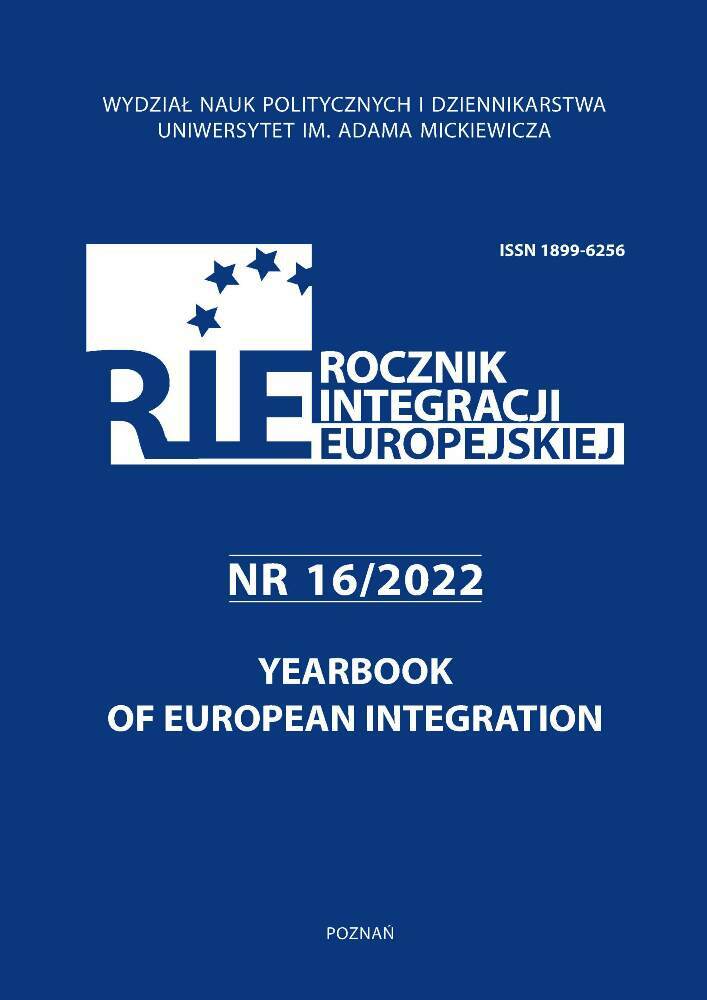Abstract
Gender equality remains a major goal of the EU, which prioritizes equality in the economic area, in the area of countering gender-based violence, and in the equal participation of women and men in political life and decision-making structures. Gender equality is a principle closely related to the observance and respect of women’s rights and an important element shaping women’s security. The article presents key documents on EU equality policy and its impact on women’s security. The author of the article adopted institutional-legal analysis as a research method, which was used to analyze the documents on the European Union equality policy, reflecting the assumptions of the policy.
References
Bain J., Masselot A. (2012), Gender Equality Law and Identity Building for Europe, "Canterbury Law Review", nr 18.
Bastic M., Whitman T. (2013), A Women's Guide to Security Sector Reform, Geneva.
Brzezińska A. (2009), Gender Equality in the Case Law of the Europen Court of Justice, "Institute for European Studies", nr 2. DOI: https://doi.org/10.2139/ssrn.1577751
Debusscher P. (2015), Gender Equality Policies in the Europen Union: Ekonomic Integration and Feminist Transnational Advocacy, "AG AboutGender International Journal of Gender Studies", vol. 4, nr 8.
Dyrektywa 75/117/EWG z dnia 10 lutego 1975 r., Dz. U. L 45 z 19.2.1975. DOI: DOI: https://doi.org/10.1111/j.1746-1561.1975.tb07664.x
Dyrektywa 76/207/EWG z dnia 9 lutego 1976 r., Dz. U. L 39 z 14.2.1976. DOI: DOI: https://doi.org/10.1108/eb056665
Dyrektywa 79/9/EWG z dnia 24 czerwca 1979 r., Dz. U. L 6 z 10.1.1979. DOI:
Dyrektywa Rady 92/85/EWG z dnia 19 października 1992 r., Dz. U. L 348 z 28.11.1992.
Dyrektywa Rady 97/80/WE z dnia 15 grudnia 1997 r., Dz. U. L 10 z 16.1.1998.
Dyrektywa Rady 2000/78/WE z dnia 27 listopada 2000 r., Dz. U. L. 303/16 z 02.12.2000. DOI: https://doi.org/10.1016/S1350-4789(00)90520-8
Dyrektywa Rady 2004/54/WE z dnia 13 grudnia 2004 r., Dz. U. L. 167 z 30.04.2004. DOI: https://doi.org/10.1641/0006-3568(2004)054[0167:NT]2.0.CO;2
Dyrektywa Parlamentu Europejskiego i Rady 2006/54/WE z dnia 5 lipca 2006 r., Dz. U. L 204 z 26.07.2006.
Ellsberg M., Heise L. (2005), Researching Violence against Women: A Practical Guide for Researchers and Activists, Geneva.
European Commission (2022), 2022 report on gender equality in the UE, Brussels.
Gender Equality Strategy 2020-2025, https://www.europarl.europa.eu/RegData/etudes/ATAG/2020/646157/EPRS_ATA(2020)646157_EN.pdf, 25.06.2022.
Gender Mainstraming, Conceptual framework, methodology and presentation of good practices (1998), Final Report of Activities of the Group of Specialists on Mainstreaming.
Hurek J., Maj M. (2012), Równość płci a innowacyjność - stan obecny i rekomendacje na przyszłość, Warszawa.
Kantola J. (2012), Polityka równości płci w Unii Europejskiej, przeł. J. Dzierzgowski, Warszawa.
Karta praw podstawowych Unii Europejskiej, Dz. U. UE. C. 2007.303.1.
Lee D. S., Guy L., Perry B., Sniffen Ch. K. (2007), Sexual Violence Prevention, "The Prevention Researcher", nr 2. DOI: https://doi.org/10.1037/e610472007-004
Liszkowska D. (2017), Integracja europejska od Traktatów Rzymskich do Unii Europejskiej, w: Unia Europejska. Geneza, funkcjonowanie, wyzwania, red. D. Byrska, K. Gawkowski, D. Liszowska, Wrocław.
Orzeszyna K. (2009), Karta Praw Podstawowych w Unii Europejskiej w Traktacie Lizbońskim, "Roczniki Nauk Prawnych", nr 2.
Podgórska-Rykała J. (2016), Polityka równości płci na szczeblu samorządowym, Sosnowiec.
Podgórska-Rykała J. (2015), Polityka równości płci - wybrane regulacje prawa międzynarodowego i europejskiego, "Roczniki Administracji i Prawa", nr 15/2.
Pollack M. A., Hafner-Burton E. (2000), Mainstreaming Gender in the European Union, "Harvard Jean Monnet Working Paper", nr 2. DOI: https://doi.org/10.1080/13501760050086116
Rossilli M. (2002), Gender Policies in the European Union, "Journal of Social Policy", nr 1.
Śledzińska-Simon A. (2001), Zasada równości i zasada niedyskryminacji w prawie Unii Europejskiej, "Studia BAS", nr 2.
Šinko M. (2018), Politika Rodnee Jednakosti Europske Unije: Javnopolitička Evolucija i Feministička Evaluacija, "Ljetopis socijalnog rada", nr 25. DOI: https://doi.org/10.3935/ljsr.v25i3.179
Strategy for Equality between women and men 2010-2015, European Commission Strategy, https://op.europa.eu/en/publication-detail/-/publication/c58de824-e42a-48ce-8d36-a16f30ef701b/language-en, 20.06.2022.
Strategic Engagement for Gender Equality Strategic Engagement 2016-2019, https://ec.europa.eu/info/sites/info/files/strategic_engagement_en.pdf, 27.06.2022.
Traktat z Amsterdamu zmieniający Traktat o Unii Europejskiej, Dz. U. 2004, Nr 90, poz. 864/31.
Traktat z Lizbony zmieniający Traktat o Unii Europejskiej, Dz. U. 2009, Nr 203, poz. 1569.
Traktat o Unii Europejskiej, Traktat z Maastricht, https://www.europarl.europa.eu/about-parliament/pl/in-the-past/the-parliament-and-the-treaties/maastricht-treaty, 24.06.2022.
Treaty of Rome (EEC), https://www.europarl.europa.eu/about-parliament/en/in-the-past/the-parliament-and-the-treaties/treaty-of-rome, 23.06.2022.
Trybunał Sprawiedliwości i równość traktowania, https://curia.europa.eu/jcms/upload/docs/application/pdf/2020-10/qd-02-20-588-pl-n.pdf, 20.07.2022.
Wawrowski Ł. (2007), Polityka równych szans. Instytucjonalne mechanizmy zwiększania partycypacji kobiet w strukturach politycznych na przykładzie państw Unii Europejskiej, Toruń.
What are Gender and Gender Equality? (2017), Geneva.
Woodward A. E. (2010), Fifty Years of European Union Gender Equality Policy and Future Challenges, "GSPR", vol. 3.
Yon A. (2007), Safer Cities for Women are Safer for Everyone, "Habitat Debate, UN-Habitat", vol. 13.
License
Copyright (c) 2022 Aleksandra Raba-Schulze

This work is licensed under a Creative Commons Attribution 4.0 International License.

